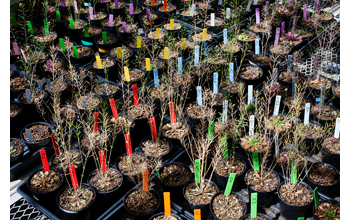Multimedia Gallery
Some Plants Duplicate DNA to Overcome Adversity
Colorful tags mark pots containing Arabidopsis thaliana, a flowering plant in the mustard family.
Researchers examining why some plants grow larger and faster and reproduce more successfully after being grazed upon by animals than they otherwise would found that some cultivars of A. thaliana can duplicate their chromosomes up to five times without undergoing cell division, a process that boosts their productivity above that of plants not damaged by grazing. The process of duplicating their chromosomes again and again without undergoing cell division is called "endoreduplication."
The research, conducted by Ken Paige, an animal biology professor at the University of Illinois at Urbana-Champaign (U of I), and doctoral student Daniel Scholes, is the first to examine the connection between the miraculous burst of growth and reproductive fitness that occurs in many plants after they have been grazed and endoreduplication.
This research was supported by the National Science Foundation and the University of Illinois Research Board. To learn more, see the U of I news release Some plants duplicate their DNA to overcome adversity. (Date of Image: July 2011)
SORRY: THIS IMAGE IS NOT AVAILABLE IN HIGH-RESOLUTION FORMAT
Credit: L. Brian Stauffer, University of Illinois at Urbana-Champaign
Images and other media in the National Science Foundation Multimedia Gallery are available for use in print and electronic material by NSF employees, members of the media, university staff, teachers and the general public. All media in the gallery are intended for personal, educational and nonprofit/non-commercial use only.
Images credited to the National Science Foundation, a federal agency, are in the public domain. The images were created by employees of the United States Government as part of their official duties or prepared by contractors as "works for hire" for NSF. You may freely use NSF-credited images and, at your discretion, credit NSF with a "Courtesy: National Science Foundation" notation.
Additional information about general usage can be found in Conditions.
Also Available:
Download the high-resolution JPG version of the image. (628 KB)
Use your mouse to right-click (Mac users may need to Ctrl-click) the link above and choose the option that will save the file or target to your computer.



